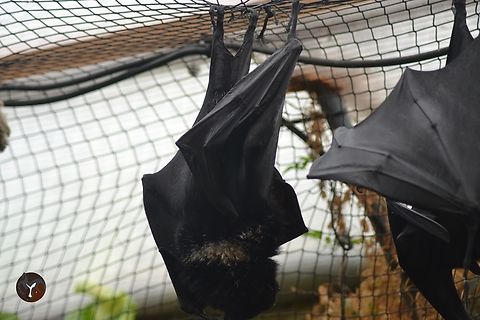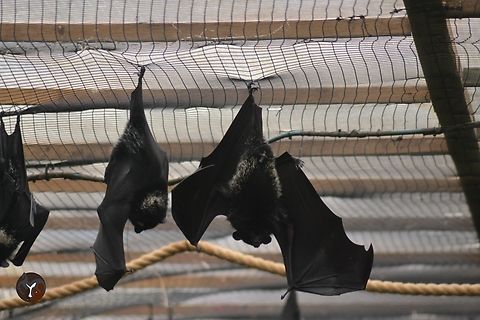
Appearance
Livingstone's fruit bats are mostly black in colour, with a scattering of golden or tawny hairs over the rump, belly, and flanks. The amount of golden hair varies between individuals, with some also having a narrow band of golden fur down the back, or golden patches on the shoulders, and others being pure black without any paler hair at all. The wings are black and hairless, as are the legs, nose, and large, rounded ears.Distinguishing characteristics include their rounded ears, the colour of their fur, and their large, orange or red eyes, reflecting this bat’s well-developed vision. Livingstone's fruit bats weigh 500 to 800 g. They have a body length of about 30 cm and a wingspan up to 1.4 m. They do not exhibit sexual dimorphism.
The bats have a relatively slow, flapping flight, and often circle in an attempt to gain height, but are also, unlike nocturnal bats, capable of soaring on air thermals. Their wings have an aspect ratio of 6.52, and a wing loading of 25.8 N/m2, and have been estimated to have a turning circle of 11.3 m.

Distribution
Livingstone's fruit bat is found only on the islands of Anjouan and Mohéli, within the Comoros archipelago between Africa and northern Madagascar. It inhabits montane forest above 200 m on Moheli and above 500 m on Anjouan.Behavior
In captivity, a colony can have a dominant male with up to eight breeding females.Livingstone’s flying foxes are active both day and night, and are predominantly nocturnal, the highest activity was observed between 10 pm and 2 am. They typically fly to a feeding site a few hours before dusk, taking advantage of hot, daytime thermals, and hang from the trees before beginning to feed after nightfall.
They forage for food primarily in the upper canopy of the forest, whereas the two other fruit bats native to the Comoros, the Seychelles fruit bat and the Comoro rousette, forage in the middle and lower canopy, respectively.
The diet of Livingstone's fruit bats consists of fruit, pollen, nectar, seeds, and leaves. They have also been observed to hunt and eat moths in captivity.
They drive off intruders on their feeding territory with chattering sounds, clapping their wings, and chasing, sometimes culminating in clawing and biting. When alarmed, they make squeaking sounds or a deep series of "clucks".
After mating, the pregnant females relocate to maternity roost sites to give birth and raise their young until they reach maturity. They give birth to a single pup, typically in early September. The young pups are born fully furred and with their eyes open; their big feet are used to grip onto their mothers directly after birth. They begin to forage at 2.5 to 5.0 months of age, and males begin to establish territories at 6 months.
References:
Some text fragments are auto parsed from Wikipedia.